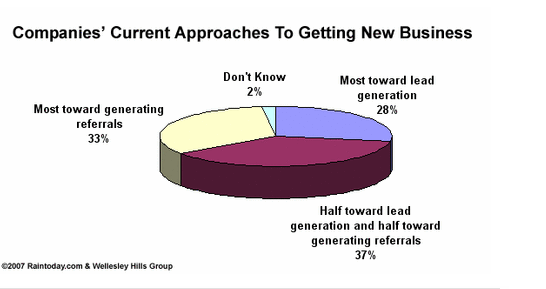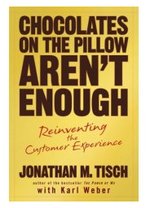How do you chase new business?
March 2, 2007
A resource that I have enjoyed for a long time is RainToday.com. They describe themselves as "your online source for insight, advice and tools for growing your service business."
And they are certainly that. I almost always find gems of insight in their articles.
They have just released a new research report What’s Working In Lead Generation. (with the obligatory sub head: How to Spend Your Time, Energy & Money for the Best Marketing ROI in B2B Professional Services.)
They’ve been kind enough to share a press review copy of the report with me and over the next several posts, I’d like to share with you some of the wisdom their research has uncovered.
As we always should, let’s start with where we’re at today.
The report goes on to say that:
45% responded that finding a lead generation strategy, tactic, or offer that works well is "extremely challenging" or "very challenging".
84% of respondents reported that in the next two years they will increase their lead generation efforts.
What does that mean for us? First, everyone agrees that finding new business is no small or easy task. And to reduce it to that probably means you aren’t really doing so hot at getting it done. The second and potentially alarming stat says that the competition is getting ready to gear it up.
Are you ready? What is your lead generation plan? Is it automated enough that if you get busy — it keeps chugging along?
For many small businesses, this is the biggest challenge. They launch a lead generation tactic or plan and it works. Yeah! But also — Boo! Because the plan is too dependent on their man hours. And now the man hours are consumed with taking care of the new business they just generated.
Once they get that new business under their belt — the pipeline is dry again because they could only do so much and then the work got in the way of continuing to fill the pipeline.
What do you have in place to prevent that?
More insights from the report are on the way….
Note: The full RainToday.com report shares 6 key insights which I’ll be exploring over the next few days with you. In the meantime, if you’d like to download their free 21-page summary, you can grab it here.
More

![Reblog this post [with Zemanta]](http://img.zemanta.com/reblog_e.png?x-id=a21864e3-a105-4eec-828f-490058ddd23c)

![Reblog this post [with Zemanta]](http://img.zemanta.com/reblog_e.png?x-id=7f822729-736e-4186-9e99-c6044274fa02)

![Reblog this post [with Zemanta]](http://img.zemanta.com/reblog_e.png?x-id=8505741b-4543-472e-9cd7-d7a45b6654b3)